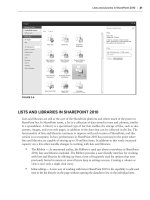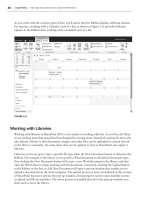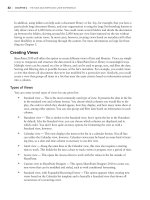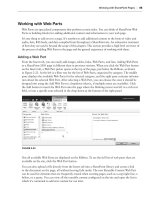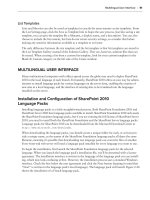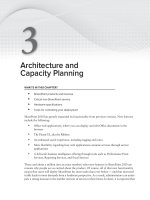Thủ thuật Sharepoint 2010 part 03 pdf
Bạn đang xem bản rút gọn của tài liệu. Xem và tải ngay bản đầy đủ của tài liệu tại đây (584.63 KB, 7 trang )
The New and Improved User
Experience
WhAt’S IN thIS chAPtER?
Browser support in SharePoint 2010
Updated user interface features
Using sites, lists, libraries, and and views
Working with pages in SharePoint
Using the Multilingual User Interface
You may fi nd yourself wondering what a chapter on the SharePoint user experience is doing in
an administration book. Well, the answer to that is twofold. First, it is important for admin-
istrators to know at least a little about what SharePoint 2010 can do from a user’s standpoint
and how it differs from its predecessor, SharePoint 2007, in terms of functionality. It’s one
thing to know how to deploy, confi gure, and maintain SharePoint from the backend, but it’s
another to actually understand what the program can do, what end users will be experiencing,
and how it can help your organization. Often, administrators are the ones who will get ques-
tions from end users regarding functionality or how to accomplish certain tasks. Having an
understanding of the interface will allow administrators to help users more quickly. In addi-
tion, some settings can only be enabled at a site level. Understanding Central Administration is
only half of the picture. Turning on the option to allow incoming e-mail for document librar-
ies, for example, is done in Central Administration, but what about when a user needs help
actually confi guring a document library to receive e-mail? Knowing the structure and setup of
the user side of SharePoint is just as important as knowing the administration side.
This brings us to our second point. While much of the new functionality SharePoint 2010
brings to the table is for users, a lot of this information applies to administrators as well.
The Ribbon interface, for instance, is used extensively throughout SharePoint 2010, in both
2
16
chAPtER 2 the NeW aNd imProved User exPerieNce
Central Administration and in regular SharePoint sites. Understanding how it works is crucial for
administrators to do their jobs, as well as being able to help users with issues they may experience.
SharePoint 2010 offers a great new interface for accomplishing tasks. The core functionality of SharePoint
still remains and in many area has been vastly improved upon. Lists, libraries, and page editing are
all still around, as they have been in previous versions, but what makes SharePoint 2010 such
a departure from what we’ve all come to know and love is how users will interact with these
items. This chapter helps you get cozy with the ins and outs of the new user experience, or UX,
in SharePoint 2010.
SharePoint 2010 is a large, complex product. Although this chapter is designed to give you a fairly
thorough overview of using the SharePoint 2010 interface, it would be impossible to cover every
aspect of it in detail in a single chapter. Therefore, this chapter covers some of the most commonly
used areas in SharePoint 2010.
bROWSER SuPPORt
As you probably already know, SharePoint 2010 sites are accessed through a web browser. With
SharePoint 2010, Microsoft has put effort into making it more standards-compliant, meaning it will
render and behave more similarly between different browsers than in past versions. There are differ-
ent levels of browser support, however, so you shouldn’t expect that all features in SharePoint 2010
will work in exactly the same way when accessing the site with different browsers.
There are two main levels of browser support Microsoft has identifi ed to work with SharePoint
2010: Supported, and Supported with known limitations.
A supported browser is a browser that is known to be 100% compatible with all features and func-
tions in SharePoint 2010. Fully supported browsers include Internet Explorer 7 32-bit and Internet
Explorer 8 32-bit. These browsers support all ActiveX controls used in SharePoint 2010 to provide
the best and richest editing experience.
Supported browsers with known limitations are browsers that can access and use most of the
SharePoint 2010 functionality, but there are some components that either will not work or that
require a workaround to achieve the same functionality as a fully supported browser, since they may
not support all the ActiveX controls used in SharePoint 2010. These browsers also have documen-
tation readily available that lists the known limitations and workarounds. Some of these browsers
include 64-bit versions of Internet Explorer 7 and 8, Firefox 3.6 and higher (on Windows), and
Safari 4.04 on Mac OS X 10.6.
Internet Explorer 6 is offi cially an unsupported browser to use with SharePoint
2010. Due to the advanced authoring components used in SharePoint 2010,
more modern and standards-based browsers should be used instead.
Changes to the SharePoint 2010 User Interface
17
It’s important to mention that these browsers can all be used to browse a SharePoint 2010 site with
no impact on functionality. These limitations generally come into play when you are actually work-
ing with SharePoint 2010.
For more information on browser support, see
/>cc263526(office.14).aspx
.
chANgES tO thE ShAREPOINt 2010 uSER INtERFAcE
Figure 2-1 shows a screenshot of a typical out of the box SharePoint 2010 site. If you are familiar
with SharePoint 2007, you’ll notice that while many of the familiar items still exist on the page, a
few of them have been shuffled around a bit, and they’re accompanied by a few new items as well.
FIguRE 2-1
Notice that the Site Actions menu has been moved from the right side of the page to the left. The
All Site Content link has also been repositioned from the top of the left navigation menu to the bot-
tom. A few other changes to the interface include the new site navigator icon — the folder and arrow
icon — next to the Site Actions menu, which provides a tree structure of the current page’s location
in relation to the rest of the site, providing a quick way to navigate back through the site after going
a few levels deep.
18
chAPtER 2 the NeW aNd imProved User exPerieNce
In SharePoint sites, such as an Enterprise Wiki site or Team site, the site name in the title area of the
site also can serve as the root of the breadcrumb trail. Some additional, contextual, functionality has
also been built into the breadcrumb trail. For example, when working with a list, the last entry of the
breadcrumb trail displays the list view name and also serves as a drop-down to select a different view
(see Figure 2-2).
FIguRE 2-2
Also worth mentioning are the large tagging buttons, “I Like It” and “Tags & Notes,” underneath
the user login drop-down, and the rating stars that appear on some SharePoint pages. These are
covered in more detail in Chapter 17, but basically they serve as a way for users to tag certain pages
to be available to them quickly, as well as a way to rate the page’s content. Higher-rated pages will
have more relevance in search results, while lower-rated pages can serve as a good indicator to site
owners that they may want to revisit the content on the page and revise it to meet the users’ needs.
Several other UI enhancements have been made to the experience of working with SharePoint 2010 —
in particular, the addition of pop-up windows. In SharePoint 2007, it was easy to get lost when
performing certain tasks, as every click led to a new screen with new links and options. Often, it
wasn’t always apparent where SharePoint had taken you during the course of performing certain
actions, such as uploading a document, especially with multiple browser windows opening and
screens switching with every step. SharePoint 2010 addresses this problem by introducing pop-up
windows that open over the top of a page but never fully cover the page, so you still have a sense of
where you are in SharePoint.
These pop-ups aren’t new browser windows that open, but rather just new SharePoint windows
opening within the browser, letting a user perform an action, then closing, with the changes
reflected on the page without ever actually leaving the current screen. A good example is uploading
a document into a document library, as shown in Figure 2-3. Instead of leaving the document library
itself, a small pop-up window opens when the Upload button is clicked in the Ribbon, and the entire
upload process can be carried out in the pop-up. The pop-up then closes and the document appears
in the library without the user ever having left the page. This approach keeps SharePoint fairly “flat,”
as opposed to “deep,” much like the new approach to Central Administration, which you’ll learn
about in Chapter 6. There is less drill-down through SharePoint to get to the item you want.
Changes to the SharePoint 2010 User Interface
19
FIguRE 2-3
The Ribbon
Perhaps one of the most obvious and important changes to the SharePoint UX is the addition of the
Fluent UI, or the Ribbon, as it’s more commonly known. The Ribbon interface is now an integral
part of the SharePoint 2010 experience for both administrators and users alike. It works very much
like the Ribbon in the Microsoft Office 2007 and 2010 suite of clients. Also like the Office clients,
the options available in the SharePoint 2010 Ribbon change depending on the task being performed,
such as editing a page, working with an image, or working with a list. Tasks and functions are built
into a visual, contextual menu. We will examine more specific details of the Ribbon and how it can
be used in various areas of the site later in this chapter.
The Ribbon is divided into several tabs and categories, with different functions available depend-
ing on where in a site a user is working. You may also notice that the icons and text in the Ribbon
change size, expanding when more screen real estate is available, very much like the Office clients.
If the browser window is fairly small, smaller icons are used, some icons are grouped together in a
drop-down menu, and very little text is displayed. With larger browser windows, more text is dis-
played with the Ribbon buttons, and many icons are much larger. This functionality helps manage
the available real estate available in the Ribbon without reducing its functionality.
Love it or hate it, there’s no getting around using the Ribbon. There is no option to turn it off,
and nearly every aspect of SharePoint uses the Ribbon to perform tasks in some way or other,
from basic to complex. Administrators and users will likely find that the SharePoint 2010 Ribbon
makes completing most tasks easier than in previous versions. Figures 2-4 and 2-5 show examples
of the Ribbon.
FIguRE 2-4
20
chAPtER 2 the NeW aNd imProved User exPerieNce
FIguRE 2-5
The main purpose of the Ribbon is to enable more options to be available at once on a page with-
out adding additional clutter to the site. Using this approach, users should find that in most cases,
fewer clicks are required to perform a simple task. Additionally, users who are familiar with using
the Office 2007 clients will feel right at home in SharePoint 2010, as they share a similar interface.
Working with SharePoint 2010 will feel more like working with programs users already know, helping
them to become more productive.
Using the Ribbon doesn’t take much effort — generally, it is exposed when it is needed, collapsed
when it’s not, security trimmed from view if you don’t have permission to use its functional-
ity (for example, editing a page), and some options are grayed out if they can’t be utilized at
the moment. As mentioned earlier, the Ribbon interface is contextual, meaning that the set of
available options varies according to the page or location in a site. Users get a different set
of Ribbon options for working in a list than they do when working on a page. As you will learn
in Chapter 6, Central Administration even features its own Ribbon menus, such as on the Service
Application page.
cREAtINg A SItE
The site creation process in SharePoint 2010 takes one of two forms: the “classic” way that we’ve all
become familiar with from SharePoint 2007, and the new, fancy Silverlight-driven way. If Silverlight
is installed for the client browser accessing the SharePoint site, the user will be presented with the
fancy new site creation process. If not, or if the user is accessing the SharePoint site with a browser
with known limitations when working with SharePoint 2010, the classic site creation process used
in SharePoint 2007 will be presented. To begin the site creation process, click the Site Actions menu,
and then click New Site.
Figure 2-6 shows the new Silverlight-powered site creation window. The new Silverlight site creation
approach was designed to streamline and expedite the site and list creation process, since both now
use the same interface. By dividing site types into categories, which can be filtered by clicking the
category name on the left, it’s easy for users to find the type of site they want to create.
Users can select a category, choose a site type from the icons displayed, and then assign a name and
URL to the site on the right workpane. Clicking the More Options button lets you enter a description
for the site, set up unique permissions, and choose whether the site navigation will use the same items
as the parent site or use its own unique permissions.
Lists and Libraries in SharePoint 2010
21
FIguRE 2-6
LIStS ANd LIbRARIES IN ShAREPOINt 2010
Lists and libraries are still at the core of the SharePoint platform and where much of the power in
SharePoint lies. In SharePoint terms, a list is a collection of data stored in rows and columns, similar
to a spreadsheet. A library is a specialized type of list that enables the storage of files, such as doc-
uments, images, and even web pages, in addition to the data that can be collected in the list. The
functionality of lists and libraries continues to improve with each version of SharePoint, and this
version is no exception. In fact, performance in SharePoint 2010 has increased to the point where
lists and libraries are capable of storing up to 50 million items. In addition to this vastly increased
capacity are a few other notable changes to working with lists and libraries:
The Ribbon — As mentioned earlier, the Ribbon is used just about everywhere in SharePoint
2010, lists and libraries included. The Ribbon provides a user-friendly interface for working
with lists and libraries by offering up front a host of frequently used list options that were
previously buried in menus or several layers deep in settings screens. Creating a column or
view is now only a single click away.
Inline editing — A new way of working with lists in SharePoint 2010 is the capability to edit each
item in the list directly on the page without opening the datasheet view or the individual item.



